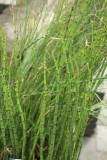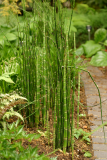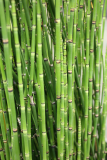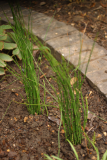Additional notes (click to expand)
Horticulture
A perennial growing to 1 m (3ft 3in) with creeping, branching rootstocks, rooted at the nodes. Upright, aerial, green stems are cylindrical, simple or with whorled branches at the jointed nodes. The surfaces of the stems are covered with silica. It flowers in early spring, producing terminal cones and seeds ripen from July to August. It likes a sunny or semi-shaded position in moist soil.
Medicinal
used by the Iroquois as a diuretic – decoction of plant taken for urinating too infrequently. Infusion of whole plant used as an eye-wash for white spot on the eye. Decoctions of the plant have been taken for kidney trouble and backache. Compound decoction of roots taken for gonorrhoea.
Moerman, Daniel E. (2009) Native American Ethnobotany. Timber Press. p.215
Medicinal uses
Uses supported by clinical data
An open clinical trial has indicated a possible diuretic effect (40).
Uses described in pharmacopoeias and well-established documents
Used internally for kidney and bladder diseases, oedema and as an adjuvant
in slimming diets (41). It is applied as irrigation therapy for infectious
and infl ammatory diseases of the genitourinary tract, and kidney
stones (12, 23, 42). Used externally as supportive treatment for slowhealing
wounds (43).
Uses described in traditional medicine
Symptomatic treatment of chronic swelling of the legs, slow-healing
sprains and fractures, irritable skin conditions, gout, rheumatism, arthritis,
hepatitis, fractures, sore throat, dermatological problems and haemorrhoids
(44–47). In folk medicine Herba Equiseti is used as an analgesic,
antihypertensive, clotting agent, haemostatic, depurative, astringent, diuretic
and anti-infl ammatory (48–50). In Indian Ayurvedic medicine it is
used for the treatment of infl ammation or benign enlargement of the
prostate gland, for urinary incontinence and for enuresis in children (51).
Contraindications
No irrigation therapy (hydrocolon therapy) is recommended in patients
with oedema due to impaired heart and kidney function (40). If signs of
hypersensitivity reactions appear, Herba Equiseti must not be used again.
WHO monographs on medicinal plants commonly used in the Newly Independent States (NIS). 2010. WHO, Geneva
HISTORICAL ** "Gauda [a typo for Cauda] equine. Horsetail; is of a drying binding quality, cures wounds, and is an admirable remedy for sinews that are shrunk; yea, Galen saith that it cures sinews though they be cut in sunder; but Columbus holds that is incurable unless they be cut within the muscle; well then, take Galen in the charitable sense. ... it is a sure remedy for bleeding at the nose, or by wound, stops the terms in women, Fluxes, Ulcers in the Reins [kidneys] or Bladder, coughs, ulcers, in the lungues, Difficulty of breathing."
Nomenclature
Previously grown as Equisetum hyemale var. affine
Plants of the World online, Kew Science http://www.plantsoftheworldonline.org/taxon/urn:lsid:ipni.org:names:93005-2
link
Other use
Otherwise known as the “Scouring or Dutch Rush”, Professor Dayan contributes that “…the high silica content of the stems has led to their use for scouring pots and pans and polishing metal. It was once imported from the Netherlands to Britain.”
In Japan, the stems have been used as fine sandpaper. The stems are first bleached by repeated wetting and drying in the sun. They can also be used as a polish for wooden floors and furniture. The infused stem is an effective fungicide against mildew, mint rust and blackspot on roses. It also makes a liquid feed. Used as a hair rinse it can eliminate fleas, lice and mites. A light pink dye is obtained from the stem. The hollow stems have been used as whistles. Another report says that the stem joints are pulled apart and used by children to produce a whistling sound.
Plants for a Future (2016) at www.plantsforafuture.org.uk
The Karok have use the dried stalks to sharpen mussel shell scrapes and for polishing arrows.
Moerman, Daniel E. (2009) Native American Ethnobotany. Timber Press. p.215
Horsetails have an unusual chemistry compared to most other plants. They are rich in silica, contain several alkaloids (including nicotine). Caution is advised (see notes under toxicity). The peeled stems, base of the plant, root and tubers were eaten raw by the N. American Indians. The young shoots were cooked in spring and the roots dried and then cooked. It was a source of starch. Due to the high silica content eating it now is considered inadvisable.
Toxicity
Large quantities of the plant can be toxic. This is because it contains the enzyme thiaminase, a substance that can rob the body of the vitamin B complex. In small quantities this enzyme will do no harm to people eating an adequate diet that is rich in vitamin B, though large quantities can cause severe health problems. The enzyme is destroyed by heat or thorough drying, so cooking the plant will remove the thiaminase. The plant also contains equisetic acid.
Plants for a Future (2016) at www.plantsforafuture.org.uk
Toxic due to thiaminase content and high concentration of silica crystals.
Professor Anthony Dayan, 2022
Geographical distribution
- Asia-Temperate, Eastern Asia, Japan
- Northern America, Eastern Canada
- Northern America, Mexico
- Northern America, North-Central U.S.A.
- Northern America, Northeastern U.S.A.
- Northern America, Northwestern U.S.A.
- Northern America, Subarctic America
- Northern America, Subarctic America, Greenland
- Northern America, Western Canada
- Southern America, Central America, El Salvador
- Southern America, Central America, Guatemala
Equisetum praealtum Raf.
Family: EQUISETACEAEGenus: Equisetum
Species: praealtum Raf.
Common names: Scouring Rush Horsetail
Distribution summary: North South America, Japan
Hardiness: H4 - Hardy; average winter
Habitat: Frequently on sandy soils
Garden status: Currently grown
Garden location: Plants in pots (POT)
Flowering months: April, May
Reason for growing: Medicinal, toxic, traditional herbal registration
.JPG)



